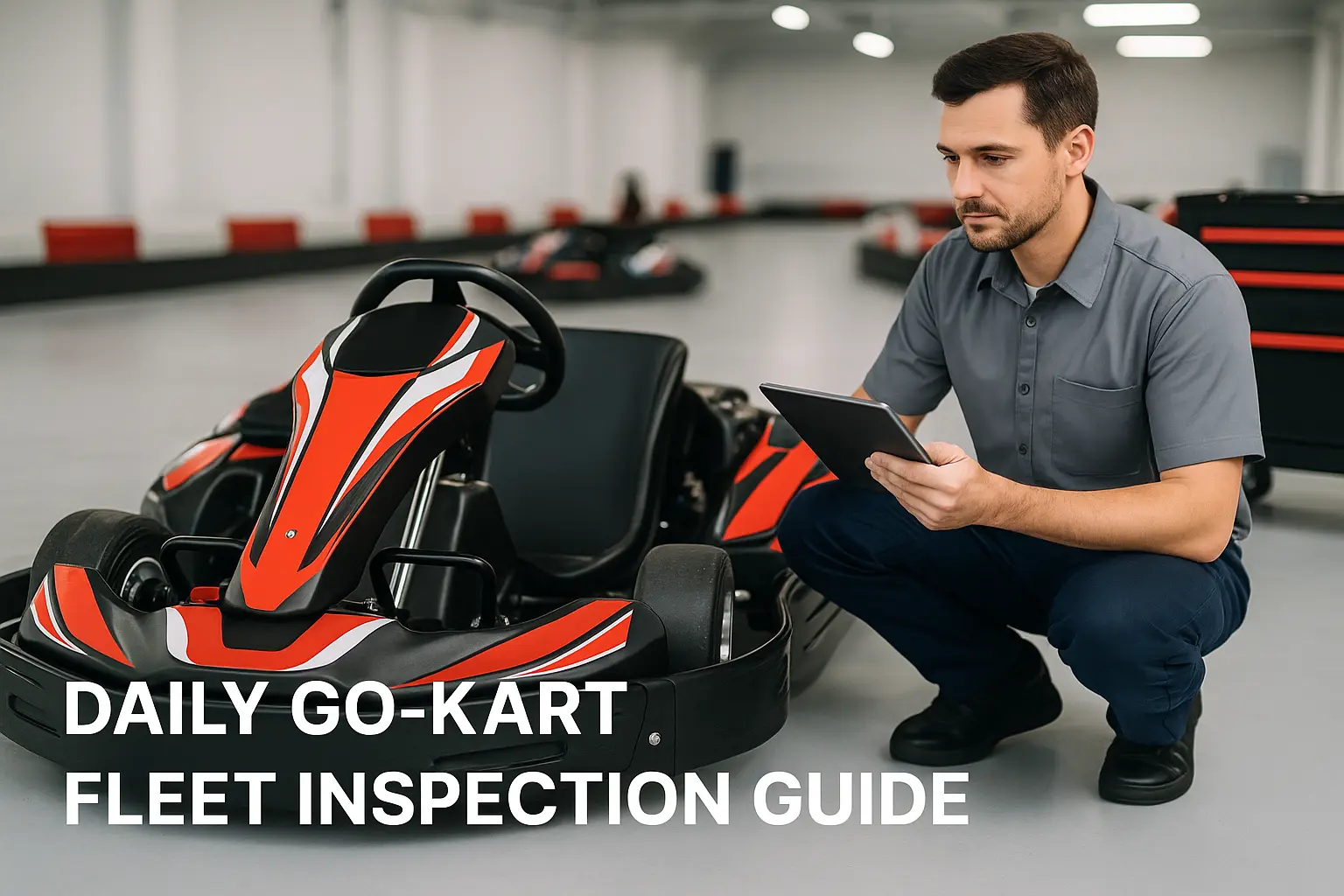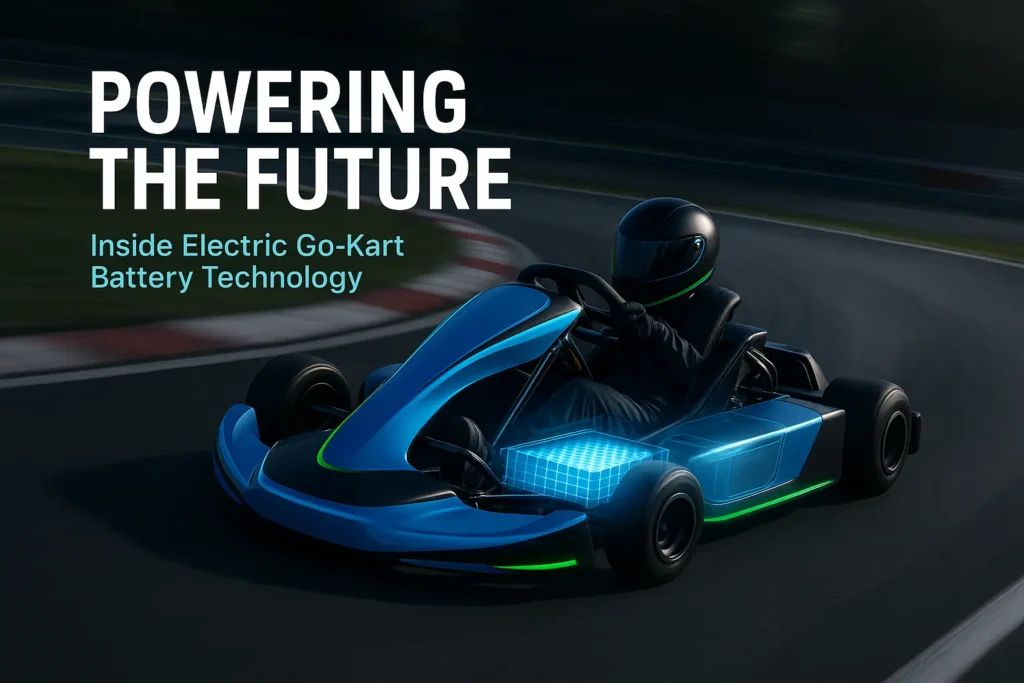Running a successful go-kart facility requires more than just exciting tracks and enthusiastic customers. The backbone of any thriving karting business is a well-maintained fleet that delivers consistent performance, ensures rider safety, and maximizes your return on investment. Daily inspections aren’t just a best practice—they’re essential for preventing costly breakdowns, reducing liability, and keeping your customers coming back for more.
Electric go-karts have revolutionized the industry with their quiet operation, instant torque, and lower maintenance requirements compared to gas-powered alternatives. However, they still demand systematic daily attention to perform at their peak. Whether you’re operating a small indoor track or managing a large outdoor facility, establishing a comprehensive inspection routine protects your assets and reputation.
Why Daily Inspections Matter
Before diving into specific procedures, it’s worth understanding why daily maintenance deserves your attention. A single malfunctioning kart can create a cascade of problems: disappointed customers, reduced track capacity, safety incidents, and emergency repair costs that dwarf the expense of preventive care. Track operators who skip daily checks often discover issues mid-session, forcing them to pull karts from rotation during peak hours.
The good news? Most problems reveal themselves through simple visual inspections and basic functionality tests. Catching a loose connection or worn brake pad early takes minutes but prevents hours of downtime later. Your maintenance routine should become as automatic as opening your facility each morning.
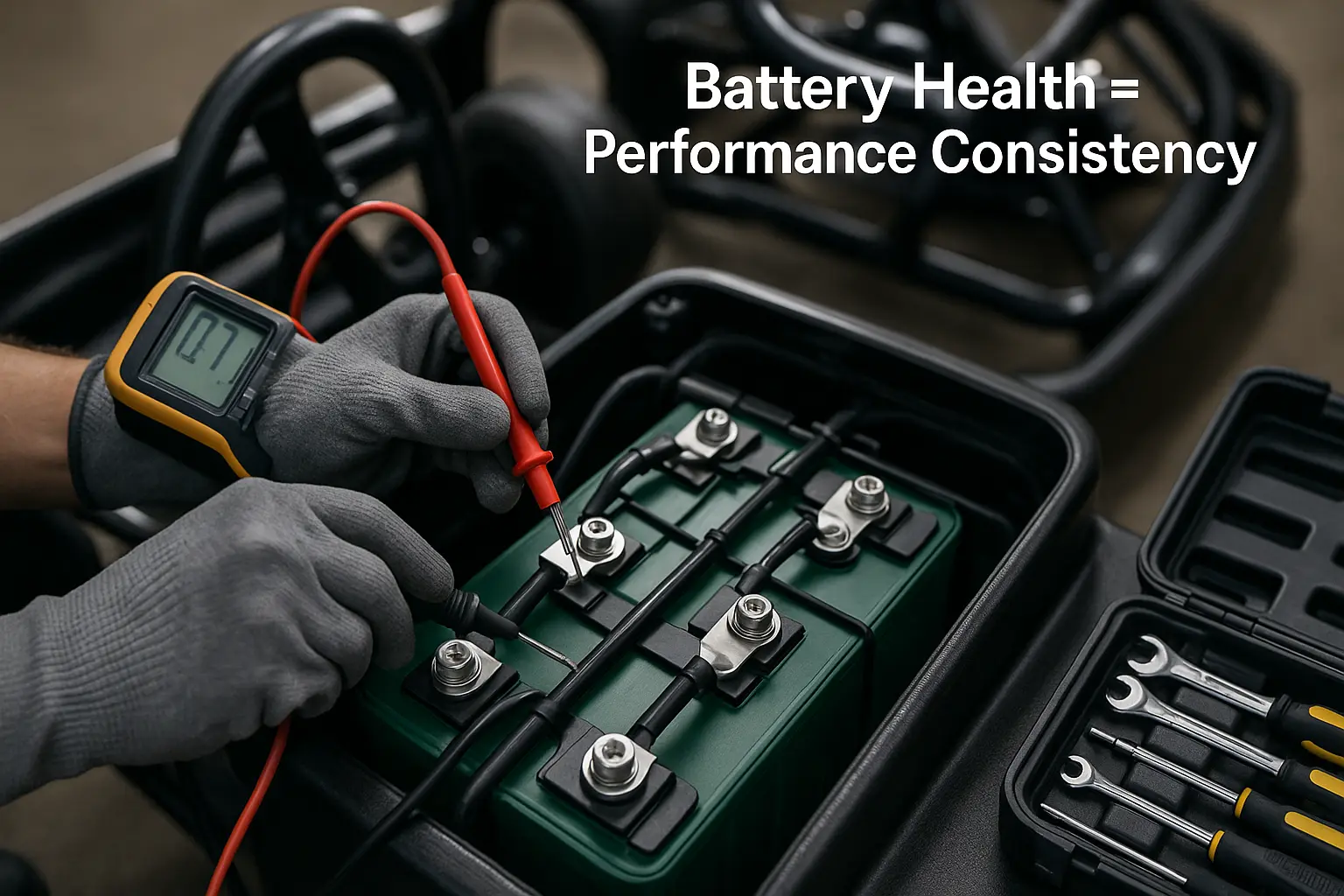
Starting with Visual Inspection
Begin every day by walking your fleet. Before any electrical systems power up, your eyes are your best diagnostic tool. Look for obvious damage: cracked body panels, missing components, fluid leaks, or signs of collision damage from the previous day’s operation.
Check each kart’s exterior carefully. Even minor cracks in the chassis can worsen quickly under operational stress. Body panels should sit flush and secure—loose panels create noise, reduce aerodynamics, and present pinch hazards. Bumpers deserve special attention since they absorb most impact forces. Deformed or detached bumpers compromise the kart’s protective design.
Move methodically around each vehicle. This isn’t the time to rush. An experienced technician can complete a thorough visual inspection in two to three minutes per kart, but newer staff may need five minutes initially. The time investment pays dividends in prevented accidents and repairs.
Tire Assessment and Pressure Management
Tires directly affect handling, speed, and safety. Inspect all four tires on each kart for proper inflation, even wear patterns, and any cuts or punctures. Electric go-karts are heavier than their gas counterparts due to battery weight, which places additional stress on tires.
Proper pressure varies by tire type and manufacturer specifications, but consistency across your fleet matters more than hitting an exact number. Mismatched pressures between karts create inconsistent lap times and handling characteristics that frustrate experienced drivers. Use a quality pressure gauge and check cold pressures before the day’s first session.
Examine tread depth and wear patterns. Uneven wear often indicates alignment issues, suspension problems, or improper pressure maintenance. Bald spots or significant tread reduction mean it’s time for replacement. Don’t wait until cords show—degraded tires lose grip progressively, increasing spin-out risks.
Rotate tires according to your manufacturer’s recommendations or every few weeks under heavy use. This extends tire life and maintains balanced handling. Keep detailed records of when each kart received new tires and rotation service.
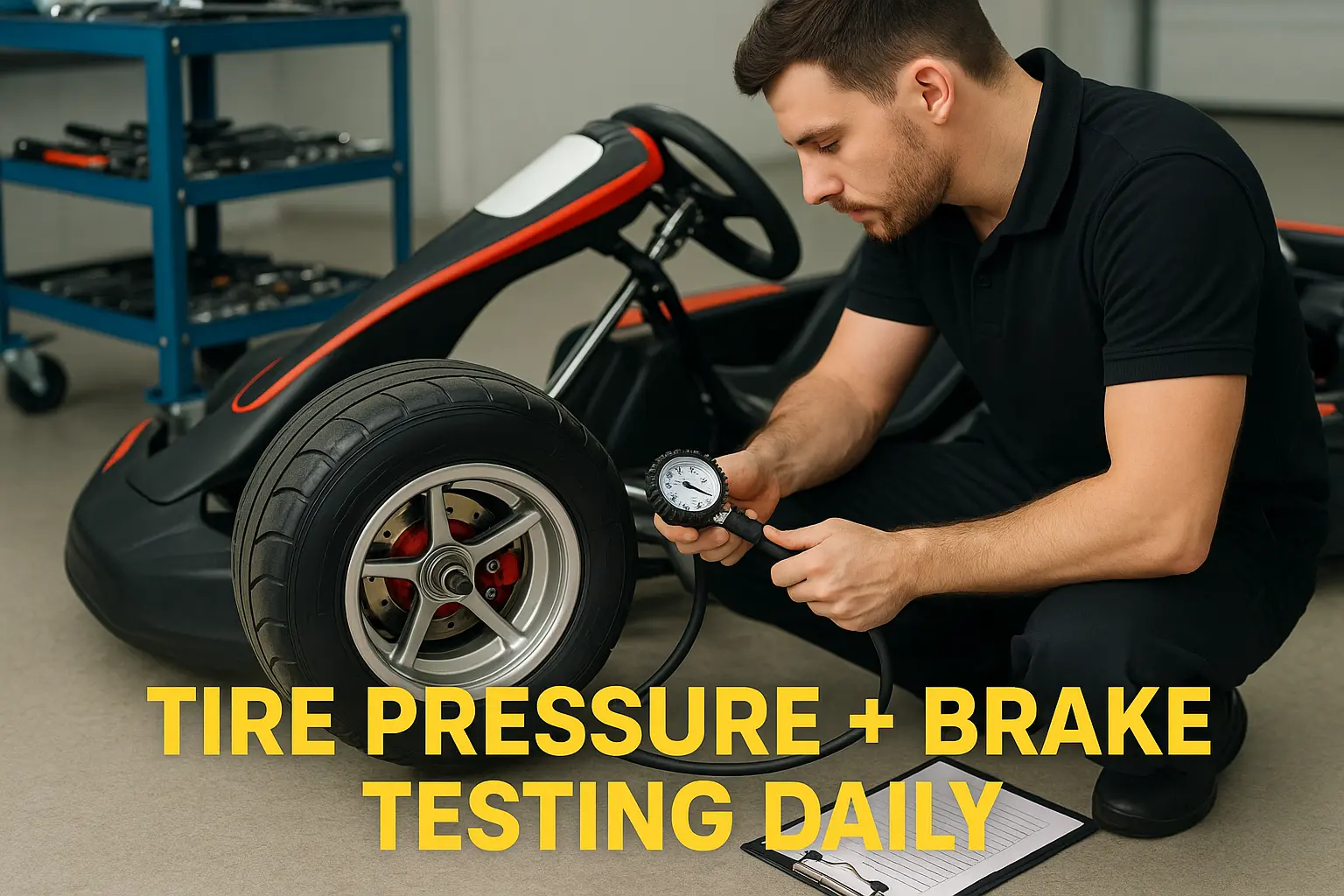
Battery System Health Check
The battery is your electric go-kart’s heart. Start each day by verifying charge levels across your fleet. Fully charged batteries ensure consistent performance throughout operating hours and prevent mid-session slowdowns that disappoint customers.
Inspect battery terminals and connections for corrosion, looseness, or damage. Vibration during operation can gradually loosen connections, increasing electrical resistance and reducing performance. Tighten any loose terminals and clean corrosion with appropriate contact cleaner. Corroded connections generate heat, waste energy, and can eventually fail completely.
Examine the battery housing for cracks, swelling, or leaks. Battery damage requires immediate attention—continuing to operate a kart with compromised batteries creates fire risks and can damage expensive electrical components. If you notice swelling or unusual heat, remove that kart from service immediately.
Check charging ports for debris, damage, or bent pins. Dirt and dust accumulate in charging ports, especially in outdoor facilities. Compressed air clears debris effectively. Damaged charging ports prevent proper connection, leading to incomplete charges and unexpected downtime.
Leading manufacturers like Minye Fun design their electric go-karts with robust battery management systems that monitor cell health and charging status. Familiarize yourself with your system’s indicators and warning lights. These systems provide early warnings about battery issues before they cause operational problems.
Brake System Testing and Maintenance
Brakes are non-negotiable safety equipment. Test every kart’s brakes before allowing customer use. This means more than just pressing the pedal—you need to verify proper response, consistent feel, and adequate stopping power.
Perform a rolling brake test in a safe area. Accelerate the kart to moderate speed and apply brakes firmly. The kart should stop smoothly without pulling to one side. Pulling indicates uneven brake wear or adjustment issues requiring immediate correction. Spongy or soft pedal feel suggests air in hydraulic lines or worn components.
Inspect brake pads or shoes for remaining material. Most systems have minimum thickness specifications—know them and check regularly. Squealing or grinding noises during braking indicate worn pads that need replacement. Don’t wait for metal-on-metal contact, which damages rotors or drums and multiplies repair costs.
Test emergency brake systems separately. These critical safety features must function independently of primary brakes. Verify that emergency stops engage properly and hold the kart stationary on inclines. Emergency brake cables can stretch or corrode, reducing effectiveness over time.
For karts with regenerative braking systems, monitor performance consistency. Regenerative braking not only helps slow the vehicle but also returns energy to the battery. If regenerative braking feels inconsistent between karts, electrical system diagnostics may be necessary.
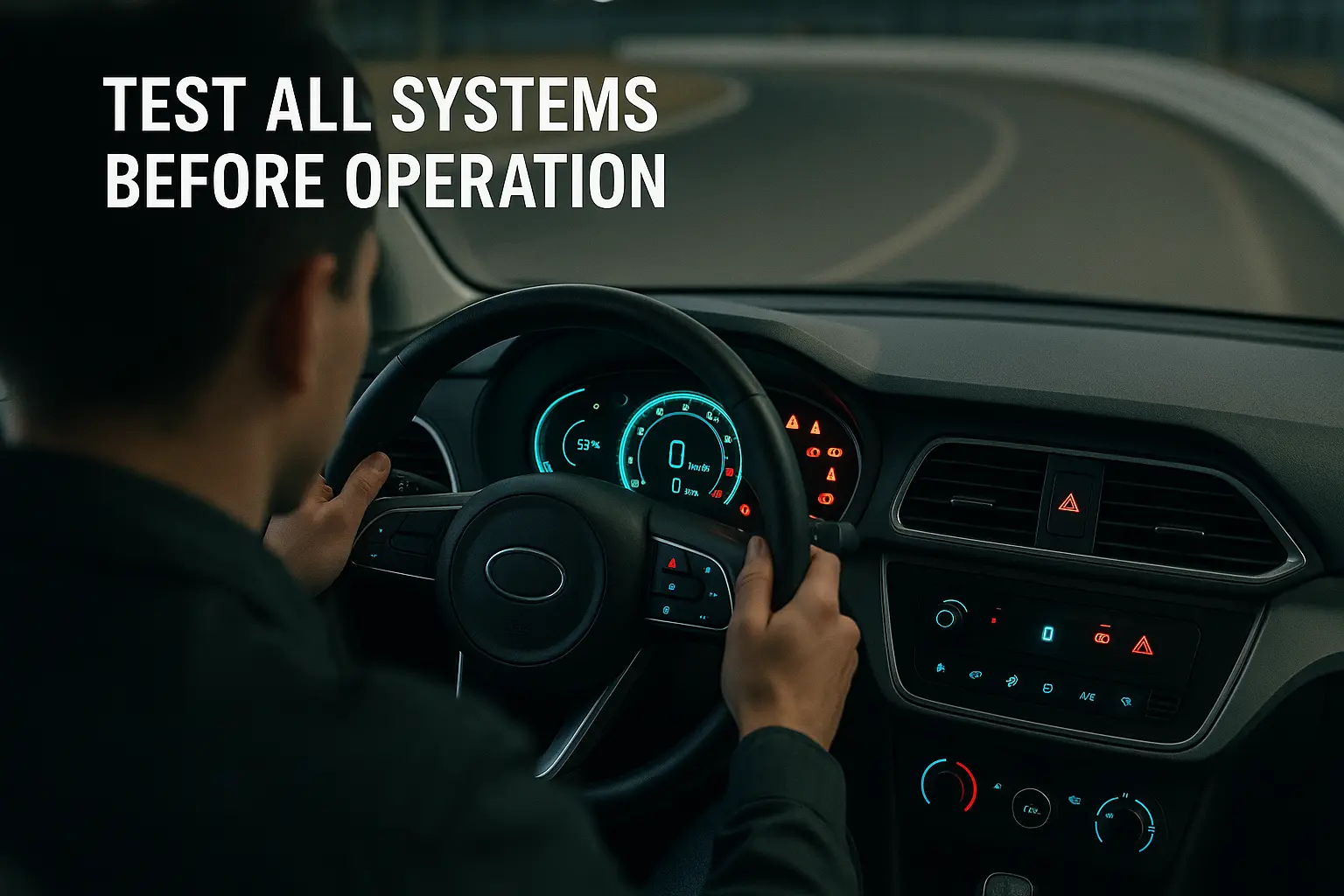
Steering and Suspension Inspection
Precise steering is fundamental to the go-kart experience. Sit in each kart and turn the steering wheel through its full range of motion. Movement should feel smooth without excessive play, binding, or unusual resistance. Excessive play creates imprecise handling that frustrates drivers and increases collision risk.
Listen for unusual noises during steering movement. Clicking, grinding, or popping sounds indicate worn bearings, loose components, or damaged steering linkages. These issues worsen rapidly under operational loads and can lead to steering failure.
Check wheel bearings by grasping each wheel at the top and bottom and attempting to rock it. Any play indicates worn bearings requiring replacement. Wheel bearing failure can cause wheels to seize or detach—catastrophic failures with serious safety implications.
Inspect suspension components for damage, wear, or looseness. While go-karts have simpler suspension than road vehicles, mounting points and bushings still wear over time. Cracked welds or bent components compromise handling and safety. If your facility includes jumps or aggressive terrain features, suspension inspection becomes even more critical.
Test shock absorbers by pushing down on each corner of the kart. It should rebound smoothly once without excessive bouncing. Failed shocks reduce handling predictability and increase stress on other components.
Electrical Systems and Motor Performance
Electric go-karts eliminate spark plugs and carburetor adjustments, but electrical system health still requires attention. Power up each kart and listen to the motor. Unusual whining, grinding, or clicking noises may indicate bearing wear or internal motor issues.
Test throttle response. Acceleration should feel smooth and progressive throughout the pedal’s range. Jerky or inconsistent throttle response suggests controller problems, throttle sensor issues, or motor problems. These create uncomfortable driving experiences and can startle drivers into accidents.
Inspect all visible wiring for damage, chafing, or loose connections. Wire harnesses route throughout the kart, and vibration can cause insulation to wear where wires contact the frame. Exposed wires create short circuit risks that can disable karts or cause fires. Use zip ties or proper clips to secure loose wiring away from moving parts and hot surfaces.
Check dashboard displays and gauges. Drivers rely on speedometers, battery level indicators, and warning lights for essential information. Non-functional displays frustrate customers and hide critical information about kart status.
Test all lights, including headlights (for indoor or evening operation) and any warning or safety lights your karts feature. Burnt-out bulbs are simple to replace but often get overlooked until customers complain.
Verify horn operation where equipped. While horns aren’t strictly necessary for all karting environments, they provide drivers a way to signal others and can prevent collisions in crowded track situations.
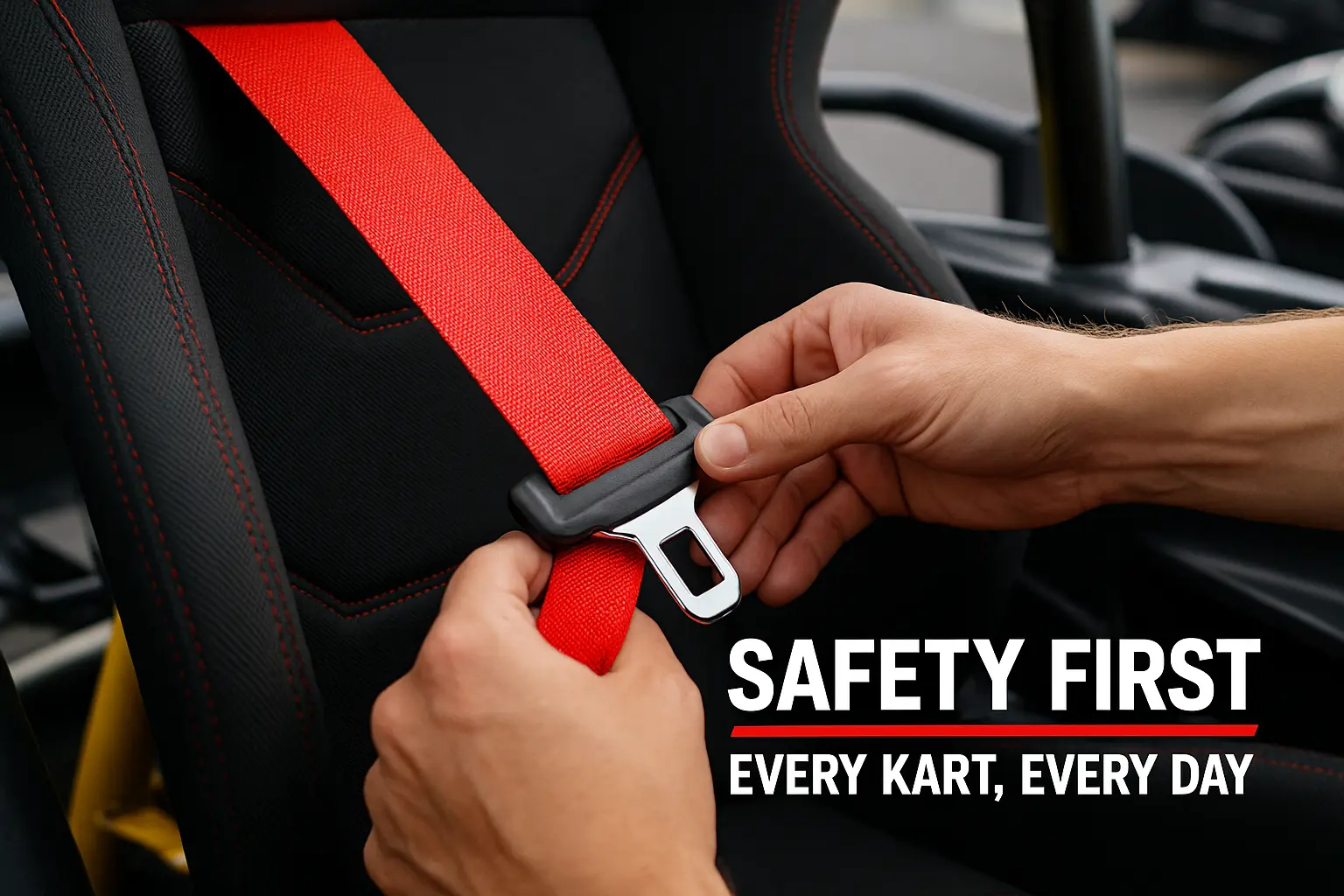
Safety Equipment Verification
Safety equipment protects your customers and your business. Inspect seat belts on every kart daily. Look for fraying, cuts, tears, or weakened webbing. Check that buckles latch securely and release smoothly. Sticky or difficult buckles frustrate customers and may cause them to skip buckling entirely.
Test belt tension. Seat belts should adjust to fit different-sized drivers properly. Worn adjusters or damaged retractors prevent proper fit, compromising protection in accidents. Replace any questionable seat belts immediately—they’re inexpensive compared to injury liability.
Examine roll bars and structural protection. While you won’t disassemble these components daily, visual inspection catches damage from collisions or stress cracks. Bent or cracked roll bars have already failed and need replacement before allowing further use.
If your karts include adjustable speed limiters or special operating modes, verify these function correctly. Speed limiters protect novice drivers and control track flow. Malfunctioning limiters that allow excessive speed or cripple performance both create problems.
Test emergency shut-off systems. Most modern electric go-karts include wireless or wired emergency stops that track operators can trigger instantly. These systems prevent serious accidents when drivers lose control or medical emergencies occur. Verify both individual kart shut-offs and any master shut-off systems protecting your entire fleet.
Minye Fun electric go-karts incorporate multiple safety layers, including speed governors, impact sensors, and remote management systems. Understanding how your safety systems work and testing them regularly ensures they’ll function when needed most.
Documentation and Record-Keeping Systems
Thorough documentation transforms reactive maintenance into predictive fleet management. Create a simple checklist for daily inspections covering every point discussed above. Digital systems work well, but even paper checklists provide accountability and track record.
Log every issue discovered, whether you fix it immediately or schedule it for later attention. This creates a maintenance history for each kart that reveals patterns. If the same kart requires frequent brake adjustments, deeper issues may need investigation. Chronic problems indicate replacement needs before failures occur during operation.
Track parts replacement timing across your fleet. Knowing when you last replaced tires, brake pads, or batteries on each kart helps predict future needs. This allows bulk purchasing and scheduled maintenance during off-peak hours rather than emergency repairs during busy times.
Modern fleet management software integrates maintenance tracking with scheduling, customer management, and financial systems. These platforms identify problematic karts, track maintenance costs, and help optimize fleet rotation. Even simple spreadsheets provide valuable insights when maintained consistently.
Record customer complaints about specific karts. If multiple customers report the same kart handles poorly or feels slow, investigate thoroughly even if daily inspections haven’t revealed obvious problems. Customer feedback often identifies subtle issues technical inspections miss.
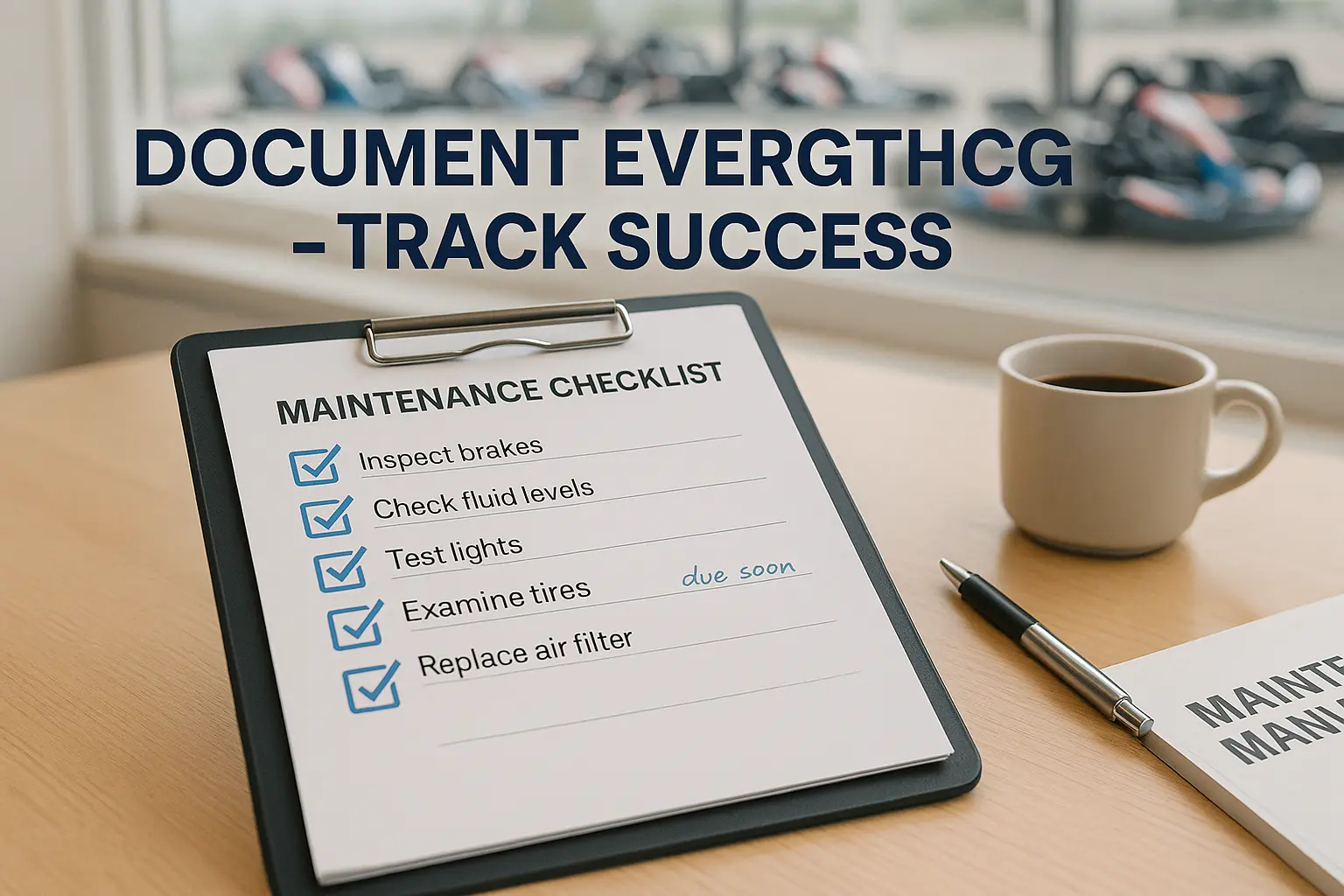
Addressing Common Issues Quickly
Despite thorough inspections, problems emerge during operation. Establish protocols for removing karts from service when issues arise. Staff should understand they have authority to sideline any kart showing concerning symptoms.
Keep essential spare parts on hand: common fuses, extra belts, basic fasteners, and a few spare tires for emergencies. While you can’t stock everything, having frequently-needed items prevents extended downtime waiting for deliveries.
Develop relationships with reliable parts suppliers or work with manufacturers who provide responsive support. Quick access to replacement parts minimizes downtime when components fail. Some operators maintain agreements with manufacturers for expedited shipping on critical components.
Train multiple staff members on basic troubleshooting and repairs. When your primary technician isn’t available, having backup personnel who can handle common issues keeps your operation running smoothly. Cross-training also provides valuable staff development and improves overall team capability.
Create a designated repair area separate from customer spaces. This allows technicians to work without distraction while keeping partially disassembled karts away from customer view. A well-organized maintenance area with proper tools and lighting makes repairs faster and more effective.
Long-Term Benefits of Consistent Maintenance
The cumulative advantages of daily maintenance extend far beyond avoiding breakdowns. Well-maintained fleets deliver consistent performance that builds customer satisfaction and positive reviews. When every kart performs similarly, customers focus on their driving experience rather than complaining about equipment quality.
Preventive maintenance reduces total ownership costs dramatically. Catching small problems before they cascade into major failures saves thousands of dollars annually on a modest fleet. A loose wire repaired during daily inspection costs nothing; the motor damage it might cause costs thousands.
Regular maintenance extends equipment lifespan. Electric go-karts represent significant capital investments. Proper care means your fleet operates profitably for years beyond what neglected equipment achieves. This improved ROI allows reinvestment in facility improvements and fleet expansion.
Safety records improve with diligent maintenance. Fewer mechanical failures mean fewer accidents, lower insurance premiums, and reduced liability exposure. Your reputation benefits when customers recognize your commitment to their safety through visible care of your equipment.
Staff morale improves when working with well-maintained equipment. Technicians and track operators take pride in a fleet that runs smoothly. Constantly firefighting breakdowns demoralizes teams, while systematic maintenance creates a professional environment where staff can excel.
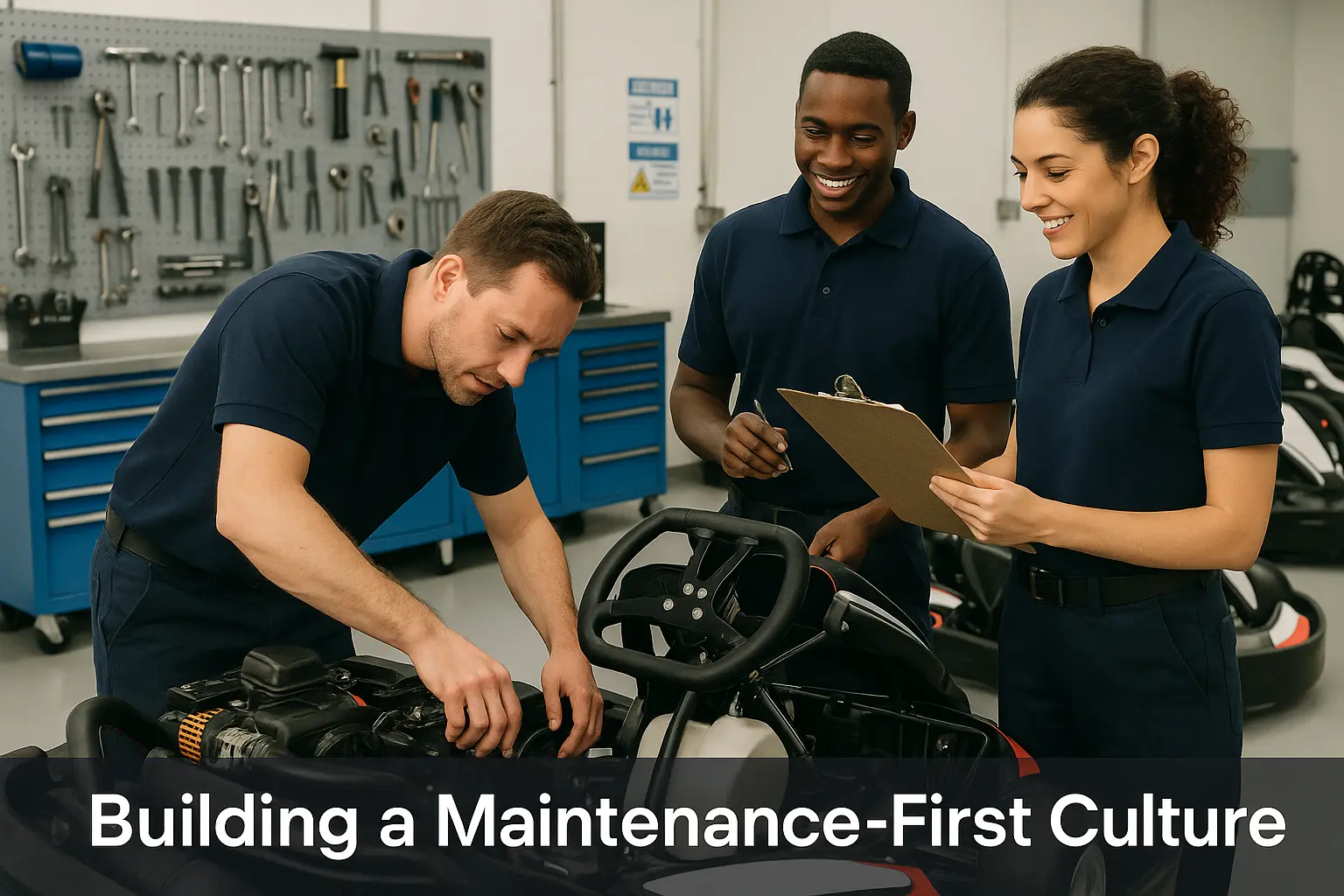
Building Your Maintenance Culture
Implementing comprehensive daily inspections requires commitment from ownership and buy-in from all staff levels. Start by providing proper training. Show staff not just what to check, but why each item matters and what problems to watch for. Understanding the reasoning behind inspections improves thoroughness.
Allocate adequate time for inspections. Rushing through checks defeats the purpose. Build inspection time into your opening procedures and staff scheduling. For a modest fleet, plan 30-60 minutes before opening, depending on fleet size and staffing levels.
Recognize and reward staff who identify problems during inspections. Creating a culture where catching issues is celebrated rather than seen as inconvenient encourages thorough work. When staff take ownership of fleet quality, consistency improves dramatically.
Review your inspection procedures quarterly. As you gain experience, you’ll identify common problems specific to your operation and can adjust checklists accordingly. Add items that prove important and streamline checks that haven’t revealed issues.
Conclusion
Daily go-kart fleet inspection and maintenance isn’t glamorous work, but it forms the foundation of successful karting facility operation. The systematic approach outlined here protects your investment, ensures customer safety, and delivers the consistent performance that builds reputation and repeat business.
Electric go-karts from quality manufacturers like Minye Fun are designed for durability and ease of maintenance, but they still require daily attention to perform optimally. By implementing thorough inspection routines, maintaining detailed records, and addressing issues promptly, you’ll minimize downtime, reduce long-term costs, and provide the high-quality experience that keeps customers returning.
Remember that maintenance is an investment, not an expense. Every minute spent on careful inspection returns multiples in avoided repairs, enhanced safety, and improved customer satisfaction. Build these practices into your operational culture, and your fleet will reward you with years of reliable, profitable service.
Start tomorrow by implementing a comprehensive daily inspection routine. Your customers, staff, and bottom line will thank you for it.

